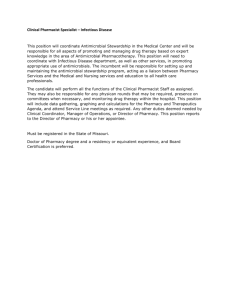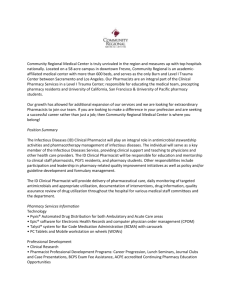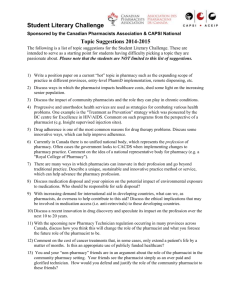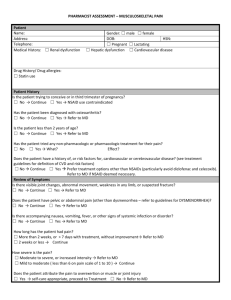Inhaler Technique Service Spec Final Oct 14
advertisement
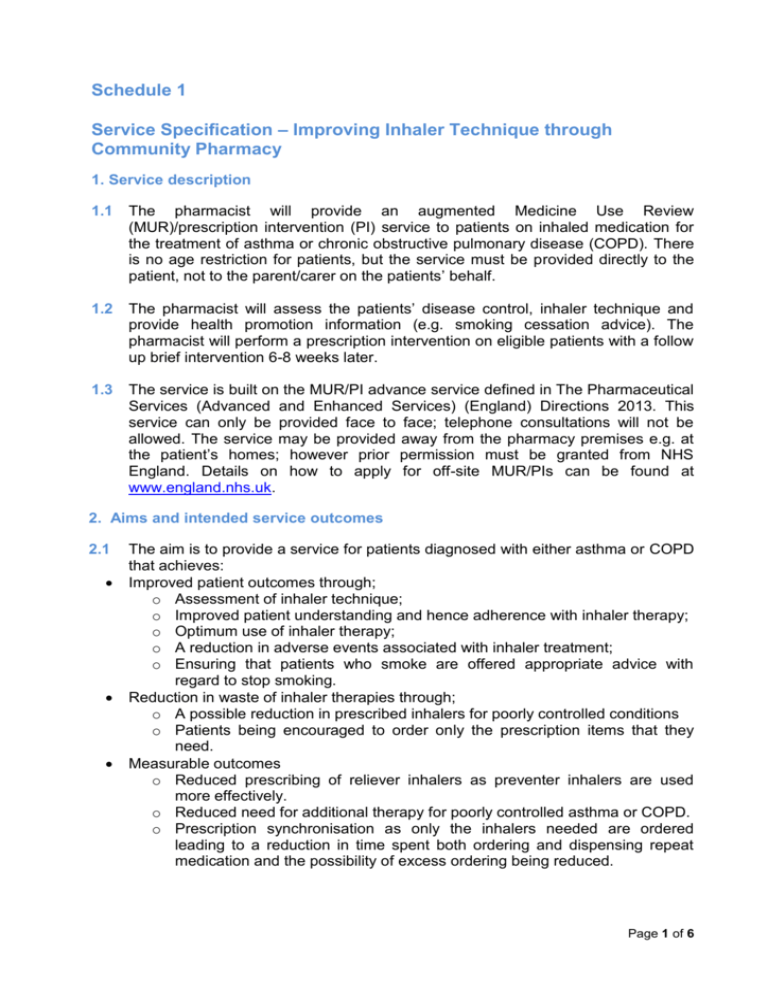
Schedule 1 Service Specification – Improving Inhaler Technique through Community Pharmacy 1. Service description 1.1 The pharmacist will provide an augmented Medicine Use Review (MUR)/prescription intervention (PI) service to patients on inhaled medication for the treatment of asthma or chronic obstructive pulmonary disease (COPD). There is no age restriction for patients, but the service must be provided directly to the patient, not to the parent/carer on the patients’ behalf. 1.2 The pharmacist will assess the patients’ disease control, inhaler technique and provide health promotion information (e.g. smoking cessation advice). The pharmacist will perform a prescription intervention on eligible patients with a follow up brief intervention 6-8 weeks later. 1.3 The service is built on the MUR/PI advance service defined in The Pharmaceutical Services (Advanced and Enhanced Services) (England) Directions 2013. This service can only be provided face to face; telephone consultations will not be allowed. The service may be provided away from the pharmacy premises e.g. at the patient’s homes; however prior permission must be granted from NHS England. Details on how to apply for off-site MUR/PIs can be found at www.england.nhs.uk. 2. Aims and intended service outcomes 2.1 The aim is to provide a service for patients diagnosed with either asthma or COPD that achieves: Improved patient outcomes through; o Assessment of inhaler technique; o Improved patient understanding and hence adherence with inhaler therapy; o Optimum use of inhaler therapy; o A reduction in adverse events associated with inhaler treatment; o Ensuring that patients who smoke are offered appropriate advice with regard to stop smoking. Reduction in waste of inhaler therapies through; o A possible reduction in prescribed inhalers for poorly controlled conditions o Patients being encouraged to order only the prescription items that they need. Measurable outcomes o Reduced prescribing of reliever inhalers as preventer inhalers are used more effectively. o Reduced need for additional therapy for poorly controlled asthma or COPD. o Prescription synchronisation as only the inhalers needed are ordered leading to a reduction in time spent both ordering and dispensing repeat medication and the possibility of excess ordering being reduced. Page 1 of 6 Improved management of patient’s asthma or COPD, measured through the use of technique demonstration and standard questions at initial screening and during follow up consultation. 3. Service outline Contractors providing this service are required to adhere to the maximum number of MUR/PIs as defined in the Drug Tariff. Any claims above this limit will be recuperated. This service shall only be provided by an accredited pharmacist. 3.1 3.2 3.3 3.4 3.5 3.6 3.7 3.8 3.9 The pharmacist shall identify suitable patients and seek written informed consent before enrolling in the service. The pharmacist shall then complete a PI focusing solely on medication for the patient’s respiratory disease with an emphasis on inhaler technique. This intervention must be clearly marked as a PI. If, in the clinical opinion of the pharmacist, the patient would benefit from a MUR/PI that covers all the patients medication at this point the pharmacist may undertake this. Alternatively they may carry out a full MUR at a later date. The PI must be completed on the Improving Inhaler Technique through Community Pharmacy- Initial Assessment form. The form can be downloaded from the Community Pharmacy Greater Manchester website, http://psnc.org.uk/community-pharmacy-greater-manchester/. The pharmacist must capture all of the information present on the assessment form, and transfer the relevant information onto the PharmOutcome module. The form must be kept in the pharmacy’s standard MUR records for post payment verification purposes. The form must be kept for a minimum of two years from the date of consultation. A copy of the form must be sent to the patients GP practice. The pharmacist should invite the patient for a brief intervention 6-8 weeks after the PI. The maximum time period between the PI and the brief intervention is 12 weeks. The brief intervention must be completed on the Improving Inhaler Technique through Community Pharmacy- Brief intervention form. The form can be downloaded from the Community Pharmacy Greater Manchester website, http://psnc.org.uk/community-pharmacy-greater-manchester/. The pharmacist must capture all of the information present on the brief intervention form, and transfer the relevant information onto the PharmOutcome module. The form must be kept with the assessment form in the pharmacy’s standard MUR records for post payment verification purposes. The form must be kept for a minimum of two years from the date of consultation. A copy of the form must be sent to the patients GP practice. This service is available to any patient registered with a Greater Manchester GP presenting to a community pharmacy in Greater Manchester who has a diagnosis of either asthma or COPD. Patients registered with GP practices outside of Greater Manchester are excluded from the service but can receive inhaler technique training via the normal MUR service. The patient is entitled to a maximum of one MUR; one PI; and one brief intervention per year. Pharmacists must take reasonable steps to ensure the patient has not received the service from a different pharmacy in the last 12 months. Patients do not have to have been using the pharmacy for a minimum time period before being offered the service. 4. Training and Premises Requirements Page 2 of 6 4.1 The pharmacy contractor has a duty to ensure that pharmacists and staff involved in the provision of the service have relevant knowledge and are appropriately trained in the operation of the service. 4.2 The pharmacy contractor has a duty to ensure that pharmacists and staff involved in the provision of the service are aware of and operate within local protocols. 4.3 The pharmacist providing this service must be accredited to provide MURs. A copy of their certificate of accreditation must be submitted to NHS England. 4.4 The pharmacist must have undertaken face to face inhaler technique training from an approved trainer since 2011. 4.5 All pharmacists providing the service are to self-declare their competence using the ‘Declaration of Competence for Improving Inhaler Technique through Community Pharmacy’ available at www.cppe.ac.uk. Pharmacist should ensure they re-accredit in line with the requirements of the ‘Declaration of Competence’. This is usually every three years. 4.6 The contractor is responsible for ensuring only pharmacists holding a valid Declaration of Competence provide the service. The contractor should retain a signed copy of the Declaration of Competence on the pharmacy premises, a copy should be provided to NHS England if requested. 4.7 All patient counselling should take place in a location approved for the provision of advanced services. It is the contractor’s responsibility that a PREM1 form has been submitted to NHS England for any on-site applications. Contractors wishing to provide the service off-site should apply to NHS England following the procedure described in the ‘provision of advanced services by pharmacy and dispensing appliance contractors’ document. 4.8 A pharmacy must be fully compliant with their Essential Services before being commissioned to provide the service. If the pharmacy becomes non-compliant with their Essential Services the scheme may be withdrawn. 4.9 A pharmacy must be fully compliant with any local services/schemes which are supported by their Local Pharmaceutical Committee to provide the service. 4.10 The pharmacy must have a selection of placebo inhalers covering the different device types. The pharmacy must also have an In-Check® device. Where possible the commissioner will provide this equipment; however the ultimately responsibility is on the pharmacy to source and purchase the equipment. 5. Service availability 5.1 5.2 5.3 Pharmacist must ensure that there are sufficient accredited members of staff are able to provide the service before enrolling a patient. If the pharmacy for whatever reason cannot provide the service, then the patient should be directed to the nearest pharmacy providing the service. The pharmacy should inform the commissioner if they are unable to provide the service for an extended period (defined as 4 weeks or more) due to any circumstance. 6. Quality Standards 6.1 The pharmacy is making full use of any promotional material for the service, made available by the commissioner. 6.2 The pharmacy has appropriate health promotion and self-care material available for the user group and promotes its uptake. 6.3 The pharmacy participates in any commissioner organised audit or post payment verification of service provision. Page 3 of 6 6.4 The pharmacy should co-operate with any commissioner-led assessment of patient experience. 6.5 The pharmacist ensures that clinical advice given is in line with national/local guidelines. 6.6 The pharmacist ensures that any patient incidents that occur are reported to the NPSA via the NRLS on-line reporting system. 6.7 The pharmacist ensures that the pharmacy has a complaints procedure in place that meets the NHS pharmaceutical contractual standards. 6.8 The pharmacist activity promotes the service to those patients 7. Claiming payment 7.1 7.2 The commissioner will provide access to a web-based system for the recording of relevant service information for the purposes of audit and the claiming of the brief intervention payment. Payment for the PI element will be made by the NHSBSA. The number of MUR/PIs should be included in the number of interventions claimed on the FP34c submission document. Page 4 of 6 Inhaler Technique Patient Pathway Flow Chart 1 Step One Patient on inhaled medication and meets the standard requirements for a MUR. Step Two Patient asked to complete the ACT/CAT assessment. Is the score ≥ 20 for ACT or ≤ 10 for CAT? Yes Patient demonstrating good control, but may have poor technique. See flow chart 2 No Step Three Patient invited to participate in inhaler training Patient not had full MUR in last 12 months Prescription Intervention undertaken on inhaled medications only- claim via FP34c 6-8 weeks later Brief intervention follow up checkclaim via PharmOutcomes Patient had full MUR in last 12 months Prescription Intervention undertaken on inhaled medications only- claim via FP34c 6-8 weeks later Brief intervention follow up checkclaim via PharmOutcomes Full MUR within 12 months- claim via FP34c Page 5 of 6 Inhaler Technique Patient Pathway Flow Chart 2 Patient has an ACT/CAT score ≥ 20 for ACT or ≤ 10 for CAT? Inspiration rate checked using InCheck® device In-correct inspiration rate demonstrated Correct inspiration rate demonstrated Does the patient meet the standard requirements for an MUR? Follow Flow Chart 1 from Step Three Yes Perform MUR- claim via FP34c No Patient to be invited back for an MUR when meets national eligibility criteria Page 6 of 6
